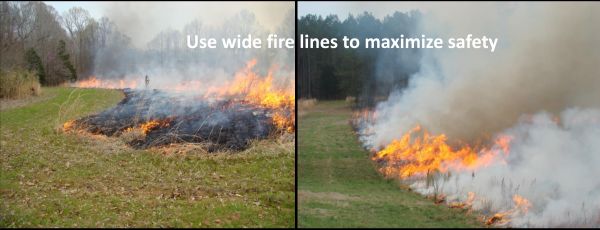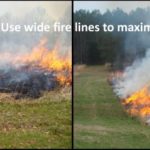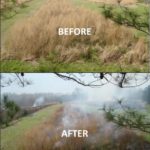
Fire can be your best friend or your worst enemy, depending on the context of how fire is used in your wildlife management program.
A “prescribed burn” is an intentional use of fire under specified conditions with proper timing in either fields or woodlands to achieve various management goals. Your goals when using prescribed burning can range from weed and brush management in fields all the way to increasing the quantity and quality of soft mast, browse, and legume and forb production in wooded areas.
When applied properly, prescribed fire can produce a very positive impact on your hunting property.
The numerous positive impacts and advantages of using fire on your property are offset by definite risks and negative effects if the intentional use of fire is not done properly and responsibly. Do not even consider using fire on your land unless the process will be implemented and managed by a professional who is properly trained and certified. Be sure to carefully check your state’s laws regarding prescribed burning to see exactly what steps must be followed to minimize your risks and liabilities.
In Mississippi, the Prescribed Burning Act of 1992 was passed by the Mississippi Legislature in 1993, codifying the rights and responsibilities of landowners to use prescribed burning.
To assist you with a controlled burn and to reduce your liabilities, hiring a certified burn manager to set up and administer the burn will be the best money that you will ever spend. Contact your state Forestry Commission office or go to their Web site for assistance in finding qualified individuals who have the necessary training and certification to properly and safely administer your burn.
The frequency and timing of prescribed burns will depend on a landowner’s overall goals and objectives. There are various ecological and management benefits of using prescribed fire. The list of benefits includes:
• Restoration and maintenance of natural ecosystems.
• Reduction of forest floor fuel supplies, thereby inhibiting wildfire destruction.
• Improvement of wildlife habitat and food sources.
Regarding timber stand improvement for wildlife, prescribed fire is a basic and standard practice in stands of pine timber to remove competing, undesirable hardwoods, reduce the potential threat of future wildfires and to improve wildlife habitat.
A prescribed burn is not often recommended for stands of hardwood, as the thin bark of hardwood trees can be easily damaged by fire. The tougher and thicker bark of pine trees acts as an insulator for the sensitive inner cambium layer, which greatly reduces or eliminates heat damage from fire.
Woodland burns eliminate the thatch-like fuel load that builds up over time, releasing nutrients and kick-starting a cycle of renewal that results in a diverse selection of seedlings and sprouts for the herbivore segment of your wildlife population.
The long-term result of a series of controlled woodland burns is restoration of native vegetation and a marked decrease in fuel loads that could feed a destructive wild fire.
Here in the Southeast, the general guidelines for a controlled burn recommend a cool-season fire (usually the December to March time frame) on a three- to five-year interval, burning in 20 to 200 acre blocks.
On the other hand, a program of controlled burns in old field habitats helps to maintain the early successional components of plant growth, and maximize forage quantity and quality.
Periodic burns on your property, when conducted and timed properly, help with weed and brush management; plus, a burn recycles nutrients that are tied up in old plant growth.
The accompanying photos are from the latest controlled field burn that I conducted on my property. The controlled burn was conducted on an old 20-acre field I had compartmentalized with fire breaks into about eight separate burn units. The compartmentalization allowed us to burn the entire field slowly, segment-by-segment, making the burn more manageable and safe.
The two most critical components of a safe and successful prescribed burn are controlling the fire and minimizing the off-site impact of smoke.
Weather conditions on the day of a proposed burn, such as relative humidity, wind direction and speed, will determine whether it is safe to go ahead with the burn and where the smoke will go.
This is the point where your hired professional will really earn his or her keep. Is it safe to go ahead with the burn? If safe, when should the burn start; and if we go ahead, when should it end? An early start is usually advisable, as the humidity tends to decrease and the wind tends to increase as the day proceeds.
This article just outlines the bare essentials behind the science of controlled burns. Study up on the subject thoroughly and consult with an experienced professional before you proceed with a burn.
When applied correctly and safely, prescribed fire can greatly improve the habitat for deer, turkey, quail and rabbit on your hunting property.




